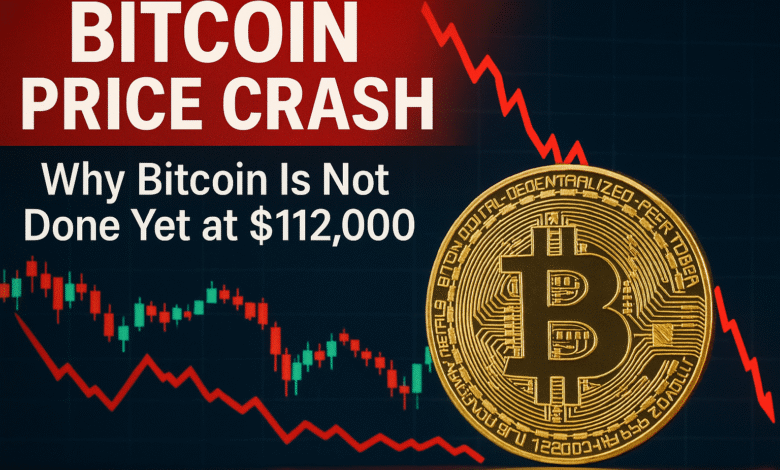Bitcoin Price Crash Why Bitcoin Is Not Done Yet at $112,000
Despite the Bitcoin price crash, data shows BTC isn’t done yet at $112,000. Discover on-chain, macro, and cycle factors that still favor upside.

The headlines scream panic whenever the market whipsaws, and the latest move is no exception. After a blistering rally, a sharp pullback has many wondering if the cycle has topped and whether the long-term thesis is broken. But a closer look reveals a different story. Despite the noise around a sudden plunge, the context at $112,000 paints a market still building its foundation for the next leg.
From on-chain activity to macro liquidity, from supply dynamics to adoption curves, the evidence suggests the Bitcoin price crash may be dramatic but not decisive. Suppose you zoom out beyond a few volatile sessions. In that case, the market’s structure remains resilient, risk is rotating rather than disappearing, and historically reliable indicators continue to imply unfinished business for the current cycle. In short, Bitcoin price crash headlines don’t tell the whole story—and certainly don’t prove that Bitcoin is done yet.
Bitcoin Price Crash
It’s tempting to interpret a swift drawdown as a trend reversal. Yet the Bitcoin price crash must be viewed through the lens of crypto’s structural volatility. Bitcoin’s historical path to new highs has always included rapid retracements that shake out weak hands, reset leverage, and prepare the market for healthier advances.
These corrections are not outliers; they are how liquidity migrates, how risk is repriced, and how long-term holders take the baton from leveraged speculators. When a market rallies quickly, open interest and funding rates climb; when it corrects, forced liquidations flush that leverage. What appears to be failure on the surface is often a necessary reset under the hood. This is why a Bitcoin price crash does not automatically imply a macro top. Instead, it can mark a shift in market participants, from momentum chasers to patient allocators, creating a more stable base.
Why $112,000 is a waypoint, not an endpoint
Price levels become talismans in bull markets, but they’re just snapshots of liquidity at a moment in time. The Bitcoin price crash to $112,000 should be read as a waypoint where supply met demand under stress conditions. Whales locking in partial profits, funds rebalancing, and systematic strategies de-risking can collectively nudge the price below fair value temporarily.
After that, the market explores lower liquidity pockets, tests support, and ultimately finds equilibrium where long-term buyers are willing to accumulate. If the long-term thesis were invalidated, we would likely see sustained on-chain distribution from older coins, a drop in network security, and a contraction in institutional flows. Instead, what emerges around $112,000 appears to be rotation and consolidation, rather than capitulation.
The halving flywheel and programmatic scarcity still matter.
Programmatic scarcity doesn’t stop working because of a headline. The block subsidy halving rhythmically constrains new supply, nudging miners and markets into a game of patience. Each cycle, the Bitcoin price crashes essentially correspond to the market testing how fast it can move relative to the new issuance schedule. Miners budget differently, sell pressure evolves, and the marginal buyer adjusts.
Over time, reduced issuance tightens the float, making demand shocks more potent. That mechanical underpinning did not disappear during this correction; if anything, it becomes more visible as the market gauges how much post-halving supply miners will release at different price tiers. The scarcity flywheel continues to turn, and a violent retracement does not reverse it.
On-chain behavior separates the hands from the Capital
Investors new to Bitcoin often conflate every drawdown with doom and gloom. On-chain data tells a subtler story. During sharp market moves, short-term holders tend to realize losses and exit, while long-term holders typically remain steady or even add to their positions. These flows indicate the Bitcoin price crash moved coins from impatient entities to patient ones.
When coins migrate into wallets with longer holding histories, the realized price rises more slowly, and market resilience increases. This is consistent with prior cycles in which post-rally dips were followed by lengthy consolidation bands that set the stage for further appreciation. In other words, the transfer of supply to high-conviction owners is a feature, not a bug, of Bitcoin’s path after a correction.
Liquidity Resets and the Role of Derivatives
The fastest declines are frequently derivative-driven. Elevated funding rates, crowded long positioning, and thin weekend order books can supercharge a pullback. The Bitcoin price crash we’ve witnessed has classic hallmarks of a leverage reset: abrupt wicks into bids, waterfall liquidations, then stabilization as funding normalizes.
While unnerving, these events often improve the market’s health by clearing the froth. With funding back toward neutral and open interest trimmed, the path forward becomes less fragile. A derivative-led slump rarely kills a structurally bullish trend; instead, it cools the surface, allowing the underlying demand to reassert itself.
Macro still favors scarce, liquid, 24/7 assets
Cycles don’t unfold in a vacuum. Global liquidity, real yields, and risk appetite shape the background music. Even when rates chop sideways, fiscal dynamics, balance-sheet expansion in select economies, and persistent demand for hedge assets continue to support Bitcoin’s role in diversified portfolios. A Bitcoin price crash can occur alongside favorable macro undercurrents, especially when positioning is lopsided.
As liquidity rotates across asset classes and regions, Bitcoin benefits from being borderless and continuously tradable, absorbing flows whenever investors seek optionality against currency debasement or equity concentration risk. Pullbacks inside supportive macro regimes have historically been buying opportunities rather than cycle killers.
Institutional demand has structural momentum
Institutional adoption has shifted from “if” to “how much” and “through what vehicle.” Even if a Bitcoin price crash temporarily dents sentiment, the infrastructure—qualified custodians, transparent reporting, and portfolio construction frameworks—remain in place. Mandate changes, model portfolios, and long-only vehicles don’t pivot on a dime because of one volatile fortnight.
They scale in tranches, diversify entries, and evaluate drawdowns within risk budgets. This structural demand acts as a gravitational field. Although it may not be visible on a day-to-day basis, it steadily pulls more capital into the asset class over time, cushioning sharp declines and enabling recoveries.
Adoption curves and network effects are not linear—but they persist
Network adoption typically grows in a nonlinear manner. Users come in waves, developers build in cycles, and infrastructure matures in bursts. Periodic setbacks do not erase multi-year trends such as increasing self-custody education, payment experimentation, and layer-two throughput improvements.
When prices correct, builders continue to build. The Bitcoin price crash shakes speculators but also spotlights the value of resilient rails, self-sovereign savings, and censorship-resistant settlement. These utility anchors do not vanish during a downturn; they harden. That resilience is why Bitcoin repeatedly emerges from corrections with deeper liquidity and broader mindshare.
Market structure suggests rotation, not exhaustion

In healthy bull markets, leadership rotates. Early-cycle sprint leaders hand the baton to previously lagging segments. The Bitcoin price crash often marks this baton pass, with capital shifting from high-beta leverage to unlevered spot, from overextended altcoins back to BTC dominance, and from short-term speculation to more extended holding periods. Dominance metrics rising during dips typically signal that the market is repricing risk rather than abandoning it. As spot accumulation increases, volatility eventually compresses, and trending behavior resumes on firmer footing.
Valuation frameworks still indicate headroom
No single metric captures Bitcoin’s fair value, but a mosaic of indicators—realized cap trends, supply-last-active data, dormancy flows, and cycle-based multiples—can help triangulate risk. In prior cycles, prices spent substantial time above the realized price once momentum kicked in, punctuated by deep but brief pullbacks. The Bitcoin price crash to $112,000 tested sentiment but left many valuation anchors intact. When dormancy remains subdued and older coins stay mostly stationary, it signals that long-term participants are not distributing aggressively. That’s not what endings look like. It looks more like an intermission.
Miner behavior is rational, not terminal
Miners are professional risk managers. They sell into strength to cover costs, borrow against reserves at attractive rates, and throttle hardware expansion according to margins. A drawdown can stress weaker operators, but it also inspires industry consolidation and efficiency gains. The Bitcoin price crash does not imply miners will uniformly capitulate. Historically, broad capitulation coincides with severe price undercuts of production costs and capitulation-level hash reductions—conditions not typical of a mere leverage washout. As efficiency improves and energy strategies diversify, miners’ balance sheets are better equipped to handle volatility, thereby limiting forced selling into lows.
Psychology and time horizons: turning panic into perspective
Markets are mirrors, reflecting our time horizons. For short-term traders, the Bitcoin price crash is a storm; for long-term allocators, it’s weather. Investing frameworks that distinguish noise from signal consistently outperform emotional reactions. When price lurches lower, risk controls matter: position sizing, cash reserves, and rebalancing policies tame volatility without abandoning conviction. The paradox is that corrections feel worst when they are doing the most good—clearing excesses and delivering better forward returns. Patience is not passive; it is an active decision to let the thesis unfold over multiple seasons.
Narrative risk versus data reality
Narratives move faster than facts. A cascade of bearish headlines amplifies fear, recasts neutral data as negative, and stuffs all nuance into a single word: “crash.” However, the Bitcoin price crash label obscures dispersion beneath the surface. Spot buyers may be adding, long-term holders may remain steady, and network security may be rising even as prices wobble. When investors examine wallet age bands, realized profits and losses, and exchange reserve trends, they often find a market that is rebalancing, not unraveling. Data rarely fits the drama of a viral headline.
The path forward: base-building before expansion
After leverage flushes and funding cools, markets typically enter a base-building phase. Ranges develop, failed breakdowns trap late shorts, and higher lows begin to print. The Bitcoin price crash sets that stage by removing unstable longs and inviting disciplined spot demand. A durable base requires time and patience, but it’s precisely what extends cycles rather than shortens them. As structure forms, catalysts—such as policy shifts, liquidity inflections, or adoption milestones—can re-ignite trend days. Even without a single headline catalyst, the mere absence of additional forced selling can lift prices once sidelined capital senses stability.
Why “not done yet” is the right frame
The claim that Bitcoin is “not done yet” isn’t bravado; it’s a recognition of how crypto cycles have historically matured. The Bitcoin price crash is consistent with a mid-cycle reset, not a terminal blow-off. Until older coins sell en masse, network security weakens materially, or macro liquidity turns decisively hostile, the preconditions for an actual cycle top remain incomplete. That doesn’t guarantee a straight-line move higher—nothing does—but it argues strongly against eulogies at $112,000. Markets punish certainty; humility paired with evidence wins over time.
Practical positioning in a post-crash environment
Investors navigating a post-crash tape benefit from clarity. Define your horizon, calibrate your risk, and let allocation frameworks make the hard decisions. The Bitcoin price crash may tempt tactical heroics, but process beats impulse. Dollar-cost averaging, periodic rebalancing, and clear invalidation levels convert anxiety into discipline. If the thesis is that Bitcoin remains early in its monetization curve, then episodic volatility is the tax for long-term participation. Paying that tax strategically—rather than emotionally—keeps you in the game when the next trend resumes.
Technology tailwinds and the build-through-bear effect
One underappreciated reason Bitcoin survives every storm is the developer and infrastructure community that keeps building. Wallet UX improves, custody standards harden, Lightning and other scaling solutions iterate, and education proliferates. The Bitcoin price crash doesn’t stop hackathons, code reviews, or security audits. It fuels them, as builders become even more focused on robustness. Each cycle’s drawdowns fortify the stack, lowering friction for the next wave of users and institutions. Price eventually catches up to the improved foundations.
The adoption S-curve still has room
Bitcoin’s global penetration, even after extraordinary growth, remains modest relative to addressable markets for store-of-value assets. The Bitcoin price crash does not change that potential; it simply adjusts the pace. As infrastructure and regulation mature, barriers for conservative capital fall. Meanwhile, demographics tilt toward digital natives who assign higher probabilities to the success of digitally scarce assets. This combination—declining friction and expanding comfort—makes future demand shocks more likely, especially when supply is structurally capped.
Risk disclosures and realistic expectations
No discussion is complete without acknowledging risk. Regulatory surprises, exchange failures, macro shocks, and technological vulnerabilities can all trigger volatility. A Bitcoin price crash can often extend further than it initially seems rational. That is precisely why robust risk management is non-negotiable. But risk is not the same as inevitability. In markets characterized by asymmetry, the objective is to navigate volatility so that convex outcomes have sufficient time to materialize. Survival is a strategy, not a slogan.
Conclusion
Stepping back from the hourly chart reveals a durable reality: Bitcoin’s story is still unfolding. Supply is capped, infrastructure is sturdier, adoption is broader, and the market is more sophisticated than in prior cycles. The Bitcoin price crash to $112,000 fits within that story as a dramatic but unsurprising chapter.
If your thesis rests on digital scarcity, global liquidity cycles, and the steady institutionalization of crypto, then you can recognize the correction without abandoning conviction. Keep your framework, refine your entries, and remember that volatility is the toll on the road to potential outsized returns. If you’re ready to align action with thesis, start by revisiting your plan today—and consider building or re-building your position with a disciplined approach anchored by the Bitcoin price crash playbook.
FAQs
Q: Why did the Bitcoin price crash to $112,000?
The crash was driven mainly by leveraged liquidations, profit-taking by large holders, and macroeconomic uncertainty.
Q: Is the Bitcoin price crash a sign of the end of the bull run?
No, historical patterns suggest that such corrections are typical mid-cycle resets, not cycle-ending events.
Q: Should investors sell during a Bitcoin price crash?
Selling during panic often leads to losses; many long-term investors use crashes as opportunities to accumulate.
Q: Can Bitcoin recover after such a sharp decline?
Yes, Bitcoin has recovered from much steeper drawdowns in the past, supported by strong adoption and limited supply.
Q: What is the long-term outlook for Bitcoin after this crash?
Despite short-term volatility, long-term fundamentals, such as scarcity, institutional adoption, and global demand, remain bullish.
See More: Bitcoin and Ethereum Prices Set to Crash After FOMC Meeting Warning









